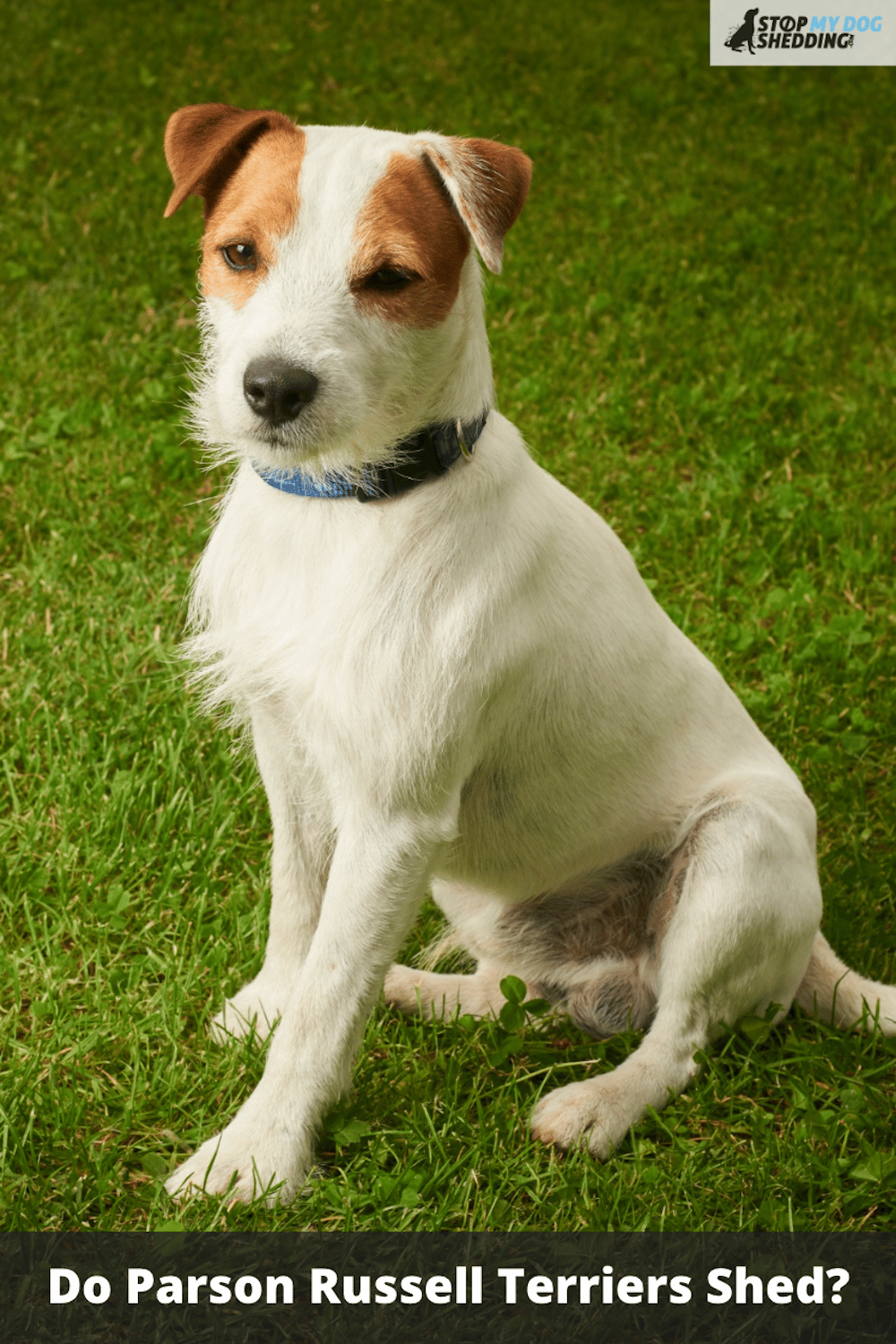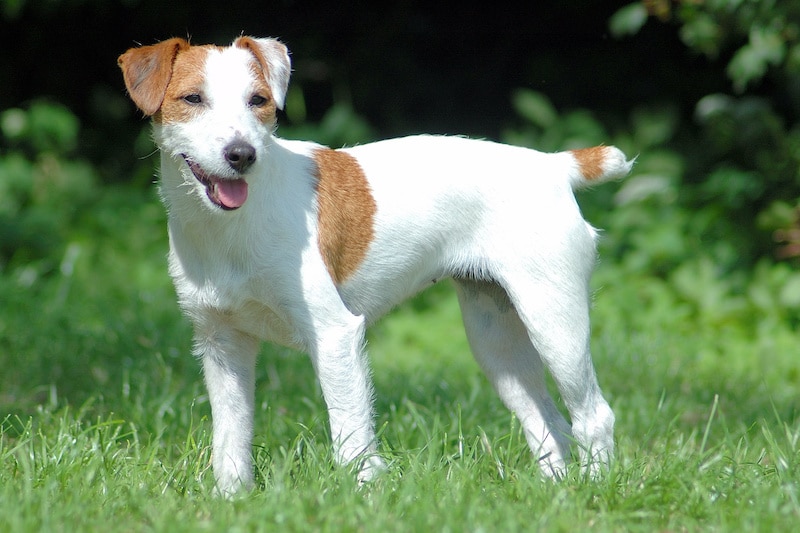The Parson Russell Terrier is a small dog that’s named for the Reverend Jack Russell, who bred the white canine into existence. With lots of energy and a feisty personality, the Parson Russell Terrier is quite a fun canine companion.
How much does this dog shed? The Parson Russell Terrier sheds little to moderately, depending on its coat type. Some have a broken or rough coat, and others have a smooth coat. The former sheds minimally, and the latter sheds more.
In this guide, I’ll explain more about this dog’s shedding behavior and what they’re like to groom. I’ll also delve into whether the Parson Russell Terrier is hypoallergenic.
So with that said, let’s get right into it!
Recommended: Go here to see our top-rated dog hair blow dryers
Parson Russell Terrier Shedding
The Parson Russell Terrier is a moderate shedder across the board, but whether it sheds lightly or more heavily depends on its coat type.
As I touched on in the intro, a Parson Russell Terrier can have two types of coats.
The first is a broken or rough coat. Although this coat texture maybe isn’t the most pleasing for petting, rough coats are often regarded as being lower-shedding.

Other Parson Russell Terriers have a smooth coat that feels great under your fingertips.

Regardless of the coat texture, this small Terrier dog has short fur, especially when compared to the Jack Russell Terrier.
And short fur is generally not conducive to minimal shedding.
The reason? All dogs grow fur across four stages.
The first stage is anagen, which is when new hair actively begins to grow. That’s followed by catagen, which is when the hair grows as long as it will.
Next is telogen, which is when the hair actively rests, followed by exogen, the shedding phase.
It’s not as clear-cut as saying that short-haired dogs shed lots by default, as not all of them do. But if a dog’s hair only grows so long, such as in the case of the Parson Russell Terrier, then its hair is more likely to come out faster than a dog with a longer coat that keeps growing.
There’s another factor that plays a role in the Parson Russell Terrier’s rate of shedding, and that’s its double-coated status.
Double-coated canines typically blow their coat twice per year.
It does depend on the dog, but the Parson Russell Terrier tends to shed ferociously late every autumn in preparation for a cold winter and grow a new, bulkier coat. Then, late into the spring, the dog will shed a second time, releasing the thick fur to grow a lighter summer coat.
Both periods are marked with weeks of heavier-than-usual shedding.
Grooming: The Key to Managing Shedding
Just as the type of coat the Parson Russell Terrier has can affect its rate of shedding, so too can its coat require you to change up your dog grooming routine.
Let me be clear that regardless of coat type, you must brush the Parson Russell Terrier.
Not only is brushing the optimal way to control shedding, as you’ll pull out loose fur before it can float all over the house, but it can help your dog’s coat develop an attractive shine.
You’re also spreading integral skin oils that can reduce itching in your pup. And as such, they are less likely to scratch to the point of shedding.
The question becomes, what type of brush to use?
If your Parson Russell Terrier has a rough coat, then I’d suggest a slicker brush or pin brush.
Alternatively, for those pups with a smooth coat, you can also use a rubber glove to brush your Parson Russell. This may not be as effective as a brush or de-shedding tool, but it can be good for dogs that don’t like regular brushes. Rubber grooming gloves can also massage your dog and help stimulate their skin, so it’s a win-win-win.
What about trimming?
If your Parson Russell Terrier has a short coat, you will likely not need to trim it. But if yours has a rough coat, you’ll likely have to trim their fur semi-regularly.
The longer, scraggly hairs the dog grows can easily become matted and tangled. Removing mats is quite painful for your dog, so nipping them in the bud early is best.
If not trimming, then you can always pluck the loose hairs.
This requires precision, so you don’t hurt your dog.
Either way, it’s almost never a good idea to shave a dog with an undercoat. So if your Parson Russell is double-coated, it’s best not to shave down to the skin, as the undercoat is what helps protect them from the elements (i.e., hot and cold weather, sunburn, and insect bites).
Feel free to bring your Parson Russell Terrier to the groomer for an occasional trim if you’re nervous about cutting their fur too short or hurting your pup by plucking.
You can also wash your dog about monthly unless your Parson Russell Terrier gets into the mud a lot when playing outside. Then bathe after a vigorous play session.
This can be a great way to remove lots of old fur, too.
Always use a canine-friendly shampoo when it’s doggy bath time, as it’s pH-balanced and will not irritate your dog’s skin (unless you use it too often, that is).
Lukewarm water is preferable as well.
When your Parson Russell emerges from the bath, what’s the best way to dry him?
If your pup has a smooth coat, towel-drying shouldn’t rough it up.
However, you cannot say the same for a broken coat.
In this case, I’d suggest using a dog hair blow dryer on a low heat setting, as these can make life a lot easier and help remove a lot of loose hair before you brush.
You don’t have to use one of these, but they can be well worth it in the long run.
How else can you reduce shedding?
One of the best ways to control shedding is with grooming, but another hugely important thing to consider is what you feed your dog. Speak to your vet about optimizing your Parson Russell’s diet, as this can help improve their skin and hair, which in turn can prevent excessive shedding.
We’ve put together a complete guide to reducing shedding, too. So if you want to know more, check out the article I just linked to, as it shows you all you need to know.
Are Parson Russell Terriers Hypoallergenic?
To some, hypoallergenic dogs are the holy grail of canines.
But before you get too excited, I want to make clear what a hypoallergenic dog is and isn’t. Then I’ll divulge whether the Parson Russell Terrier counts as hypoallergenic.
In short, a so-called “hypoallergenic dog” is less likely to cause allergy symptoms, but it’s possible for ANY dog to trigger allergies because the hair isn’t what typically causes the symptoms – it’s the dog’s dander, which is dead, flaking skin.
And since every dog has skin, dander will always be present.
So, dogs that produce less dander are typically more tolerable among allergy sufferers, as are dogs that shed less because dander sticks to a dog’s hair. The less a dog sheds, the less dander (and other allergens in a dog’s saliva, sweat, and urine) he is likely spreading around the home.
What about the Parson Russell Terrier?
As mentioned, for a dog to be deemed hypoallergenic, it will usually produce low levels of dander and be low-shedding. And unfortunately, they do not fit that bill.
So if you’re looking for a hypoallergenic dog, the Parson Russell Terrier is not it. Instead, you may want to consider an Italian Greyhound, Toy Poodle, or Bichon Frise.
Is a Parson Russell Terrier Right for You?
The Parson Russell Terrier was first bred by the Reverend John Russell, who took a Terrier who was tan and white and bred her with another dog in the 1810s.
About 40 years later, the Parson Russell Terrier was its own type of Fox Terrier. Breed standards would come about for the Parson Russell in the late 1890s.
The mostly-white dog had a knack for badger digging in its early days, and the dog still enjoys digging to this day.
The Parson Russell Terrier is an athletic, smart, and outgoing dog who’s incredibly affectionate, fairly protective, adaptable, trainable, and highly playful.
The size of a Parson Russell makes the dog a good candidate for apparent dwelling. That said, be sure to take your dog to the local dog park often to burn off its abundant amount of energy.
How are they around other pets?
The Parson Russell Terrier is a friend of nearly any dog, but the breed requires early socialization.
If you try to socialize the dog later in its life, you’ll be surprised at how aggressive the small Parson Russell will be towards other canines.
The somewhat guarded Parson Russell should also befriend any cats in the house, especially if you took the time to socialize the dog from an early age.
The two can have a harmonious and even loving relationship.
How do they behave around kids?
This dog is a companion of children through and through. The Parson Russell Terrier is very open and loving towards its favorite people. While socialization is still required, the size and temperament of this dog make it an ideal companion for children.
What about barking?
Although the Parson Russell Terrier does keep a vigilant watch over what’s happening in your home, this dog barks more than you might expect, and certainly not only when it senses that danger may be afoot. So if the pup is too loud for your liking, a behavioral training class may be in their future, as this should help you get the situation under control.
Bottom Line
The Parson Russell Terrier is a small, mostly-white dog with one of two coat types, either a smooth or broken coat.
The coat type very much plays a role in how much this dog sheds, but they are generally not considered to be low shedders, regardless of the coat, especially if yours sheds seasonally.
That said, they are far from the heaviest of shedders out there.
And getting the shedding under control is pretty easy with proper grooming.
So don’t let this put you off.
With its kind personality, proclivity for athletic activity, and friendliness around children, the Parson Russell Terrier could be just the canine companion you’ve been looking for!













Please note: By submitting a comment using the above comment form, you confirm that you agree with the storage and handling of your data by this site as detailed in our Privacy Policy.